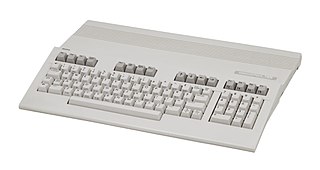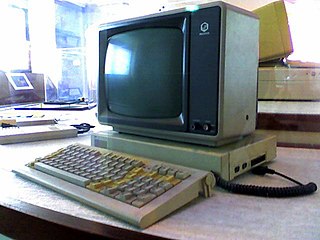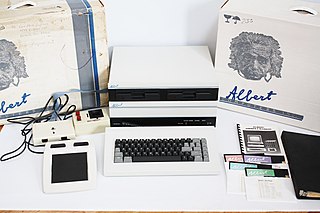Related Research Articles

The Apple II series is a family of home computers, one of the first highly successful mass-produced microcomputer products, designed primarily by Steve Wozniak, manufactured by Apple Computer, and launched in 1977 with the original Apple II.

The Apple III is a business-oriented personal computer produced by Apple Computer and released in 1980. Running the Apple SOS operating system, it was intended as the successor to the Apple II series, but was largely considered a failure in the market. It was designed to provide key features business users wanted in a personal computer: a true typewriter-style upper/lowercase keyboard and an 80-column display.

The Apple II is an early personal computer that was created by Apple Inc. It was one of the first successful mass-produced microcomputer products, and it played a significant role in the early development of the personal computer industry. It has an 8-bit microprocessor.

The Tandy 1000 is the first in a line of IBM PC compatible home computer systems produced by the Tandy Corporation for sale in its Radio Shack and Radio Shack Computer Center chains of stores. Introduced in 1984, the product line was aimed at providing affordable but capable systems for home computing or education, with some of its Tandy specific features like graphics, sound and joystick port making it more appealing for home use.

The Commodore 128, also known as the C128, C-128, or C= 128, is the last 8-bit home computer that was commercially released by Commodore Business Machines (CBM). Introduced in January 1985 at the CES in Las Vegas, it appeared three years after its predecessor, the Commodore 64, the bestselling computer of the 1980s. Approximately 2.5 million C128s were sold during its four year production run.

The Apple IIe is the third model in the Apple II series of personal computers produced by Apple Computer. It was released as the successor to the Apple II Plus. The e in the name stands for enhanced, referring to the fact that several popular features were now built-in that were formerly only available as upgrades or add-ons in earlier models. It is notable as the first Apple II to offer built-in lower-case and 80 columns text support, as well a full 64K RAM–all while reducing the total chip count from previous models by approximately 75%.

The Apple IIe Card is a compatibility card, which through hardware and software emulation, allows certain Macintosh computers to run software designed for the Apple II series of computers. Released in March 1991 for use with the LC family, Apple targeted the card at its widely dominated educational market to ease the transition from Apple II-based classrooms, with thousands of entrenched educational software titles, to Macintosh-based classrooms.

The Apple IIGS is a 16-bit personal computer produced by Apple Computer. It is the fifth and most powerful of the Apple II family. It is compatible with earlier Apple II models but has a Macintosh look and feel, and resolution and color similar to the Amiga and Atari ST. The "GS" in the name stands for "Graphics and Sound", referring to its enhanced multimedia hardware, especially its state-of-the-art audio.

The Apple IIc is a personal computer that was introduced by Apple Inc. shortly after the launch of the original Macintosh. It was a compact and portable version of the Apple II series of computers. The IIc featured a built-in floppy disk drive and a keyboard, and was often sold with its matching monitor. The c in the name stood for compact, referring to the fact it was a complete Apple II computer setup with a floppy drive that was squeezed into a smaller notebook-sized housing. It was compatible with a wide range of software and peripherals.

The Laser 128 is an Apple II clone, released by VTech in 1986 and comparable to the Apple IIe and Apple IIc.

Microprofessor III, introduced in 1983, was Multitech's third branded computer product and also (arguably) one of the first Apple IIe clones. Unlike the two earlier computers, its design was influenced by the IBM personal computer. Because of some additional functions in the ROM and different graphics routines, the MPF III was not totally compatible with the original Apple IIe computer.

Applied Engineering, headquartered in Carrollton, Texas, was a leading third-party hardware vendor for the Apple II series of computers from the early 1980s until the mid-1990s.

The Apple IIc Plus is the sixth and final model in the Apple II series of personal computers, produced by Apple Computer. The "Plus" in the name was a reference to the additional features it offered over the original portable Apple IIc, such as greater storage capacity, increased processing speed, and a general standardization of the system components. In a notable change of direction, the Apple IIc Plus, for the most part, did not introduce new technology or any further evolutionary contributions to the Apple II series, instead merely integrating existing peripherals into the original Apple IIc design. The development of the 8-bit machine was criticized by quarters more interested in the significantly more advanced 16-bit Apple IIGS.
The Apple II line of computers supported a number of Apple II peripheral cards. In an era before plug and play USB or Bluetooth connections, these were expansion cards that plugged into slots on the motherboard. They added to and extended the functionality of the base motherboard when paired with specialized software that enabled the computer to read the input/output of the devices on the other side of the cable or to take advantage of chips on the board - as was the case with memory expansion cards.

The Apple II Plus is the second model of the Apple II series of personal computers produced by Apple Computer. It was sold from June 1979 to December 1982. Approximately 380,000 II Pluses were sold during its four years in production before being replaced by the IIe in 1983.
Apple II graphics debuted on the Apple II in 1977 and were used throughout the Apple II line. They consist of a 16 color low resolution mode and a high resolution mode where visuals are dependent on artifact color. The Apple IIe added "double" versions of each of these, most prominently "double high resolution" with twice the horizontal resolution in 16 colors. Internally, Apple II graphics modes are idiosyncratic and do not simply use a linear frame buffer.
The M&R Enterprises Sup'R'Terminal was the first Apple II peripheral card to enable the display of 80 columns of text on a connected monitor. The Sup'R'Terminal is compatible with slot 03 in the Apple II and II+. As the first card making 80 columns of upper and lower case text displayable on these machines, it is the only card supported by the II+ version of Apple Writer and thus the only way to see on a monitor the true layout of text as it will be printed on a page with this popular early personal computer word processor. The Apple II and II+ had until this time only displayed 40 columns of text per line, half the characters included per line on a standard letter-size printed page at 10 characters per inch. This transition to 80-column display was an early step in bringing the WYSIWYG concept to the Apple ecosystem.

The Albert is an Apple II clone, released by Albert Computers, Inc., in 1983. Comparable to the Apple IIe, six models were ultimately produced.

The Dimension 68000 is a microcomputer introduced by the Micro Craft Corporation in 1983 that sought to emulate the Apple II, the IBM PC, and various CP/M-centric computers through a family of coprocessor expansion cards and emulation software. The Dimension 68000 can also run as a standalone computer based on the Motorola 68000 from which it gets its namesake. The computer is mostly the brainchild of Mike Carpenter, a former executive of a scientific instrument manufacturer who incorporated Micro Craft in Dallas, Texas, to develop the Dimension 68000. It had a market lifespan of three years and received mixed, mostly positive, reception from the technology press. Criticism was leveled at the $6,250 price tag for the computer with the full deck of coprocessor cards, as well as the extent of the emulation power of those cards.
References
- ↑ Apple Video Docs: Apple IIe Extended 80-Column Text Card (Rev B). Apple Computer, Inc. p. 1 . Retrieved 22 May 2020.
- ↑ Williams, Gregg; Moore, Rob (January 1985). "The Apple Story / Part 2: More History and the Apple III". BYTE (interview). pp. 166 . Retrieved October 26, 2013.
- ↑ 80-Column Text Card Manual (PDF). Apple Computer, Inc. p. 16. Retrieved 23 March 2022.
- ↑ Extended 80-Column Text Card Supplement (PDF). Apple Computer, Inc. pp. 11–12. Retrieved 23 March 2022.
- ↑ "Robot War". The Digital Antiquarian. January 30, 2012. Retrieved January 7, 2014.
- ↑ "A2 Peripheral Cards". AppleII.info. Retrieved January 7, 2014.